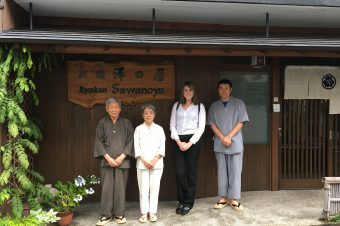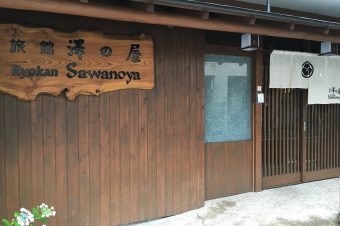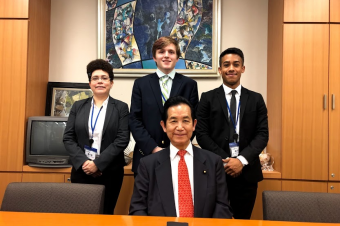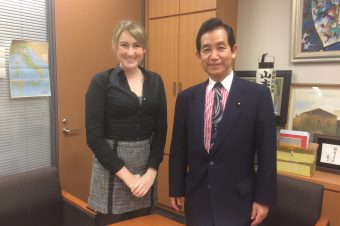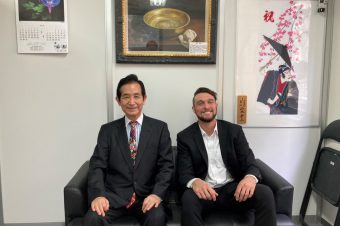| Due to Japan’s growing number of foreign in-bound tourists, a panel meeting was called to discuss how to market Japan to the United States audience. In this meeting, three American university interns and Professor Tadayuki Hara were invited to our office to answer a few questions about what they find attractive when they visit a location and how those ideas can be used to market the smaller villages and towns, as well as their shrines and temples. |
Mrs. Yamamoto:
Began the meeting by asking: “What is necessary for foreign tourists to make temples and shrines more attractive?”The interns all agreed that the most important things to have to make the shrines and temples more attractive were more multilingual informational pamphlets, such as English and Spanish, more social media presence and individual websites for each shrine and temple to ensure that in-bound tourists are aware of the existence of these shrines and temples. Individually, each intern had additional ideas and information on how to improve the marketing strategy for smaller villages and their sacred locations.
Allen:
“You need to attach people’s other interests, such as hiking, to the shrines and temples. That way, if anyone has interest in going outdoors, such as to visit Mt. Fuji, they will know about the existence of the shrines or temple. Sometimes, people will find their way into the shrine without even looking for it, such as when I went to Yugawara to visit the beach, was walking along the streets there and found several shrines and temples there. So, by connecting shrines and temples to local natural attractions, you can get more visitors at them.”
Sasha:
“Working off what Allen is saying, perhaps you should also try to connect other well-known traditions and stories to the shrines and temples. Such as sumo wrestling, which most people don’t know, was originally a Shinto ritual, and to connect such a well-known sport to a relatively unknown religion, such as Shinto, will help to gain attention and create curiosity for the shrines and Shinto. You can also connect stories about historical and mythological figures to shrines and temples, as well as smaller villages. An example would be the Tokugawa shogunate and the shrines dedicated to him and mythological characters like Momotaro and their village of origin. People are looking to escape from their world and experience a brand new one, and what better one than mystical Japan.”
Jeremiah:
“I would like to focus on the experience part of the shrines and temples, people want to experience something that they will remember for the rest of their lives. Music concerts and shows are something that people are engaged in and by having shrines and temples engage their visitors like that, it will create a bigger impact on them. You also need further understanding of user experience, also known as UX design, and how today’s generation, especially in the United States, rely on social media and internet research to learn about the location they are visiting, so creating websites for the individual shrines and temples in different languages will help create more attention for them.”

Mrs. Yamamoto:
“Thank you for answering. Our next question is; What will make inbound tourist go beyond Japan’s major cities and venture out into the local areas?”
Jeremiah:
“By employing social media, we can spread the knowledge of the shrines and temples. I’ve been posting pictures and videos of my experiences in Japan on my Instagram, and I’ve had so many people say ‘Oh, that looks so cool!’ and ‘Now I want to go to Japan!’. Using social media, we can reach thousands of people and show them the hidden gems Japan has to offer.”
Allen:
“There also needs to be access to the internet in these remote areas, so tourists can access their Google Maps and Translation apps. Most times, people don’t visit these places because they are worried there won’t be anyone who speaks the language and the signs won’t be in English, either, so they will get lost. There’s also the matter of the locals, especially the elderly, actually wanting the tourists to go to their villages.”
Mrs. Yamamoto:
“Yes, that is a problem we are having, many of the villages are just elderly people. All the younger people are leaving for the bigger cities and are leaving the villages empty.”
Sasha:
“In that case, the first thing that needs to be done is to find a way to keep the ‘local generation’ from leaving the villages. There needs to be a law or legislature that promotes the teaching of traditions and history in school and perhaps propose an apprenticeship program with the artisans and craftsmen of their villages and towns. If today’s generation is not taught where they come from, if they don’t build a strong connecting with their roots, they will have no qualms about leaving everything in their village behind. I have already seen and experienced this in my home of Puerto Rico, and I would prefer not to see it happen here.”
Mrs. Yamamoto:
“And our last question is; from a foreigner’s point of view, how can we show how different we are from the rest of Asian countries?”
Prof. Hara:
“This is a very important question, because some tourists tend to place us together with all of the Asian cultures and cannot differentiate us. I just had someone at the airport on my way here say “Oh, you’re Jackie Chan!”, and while it was flattering, Jackie Chan is not Japanese, and I am not Chinese. There are somethings that people recognize as intrinsically Japanese, such as the cherry blossom trees and Mt. Fuji.”
Allen:
“Well, that’s mostly the older generation, like the Baby Boomers, that tend to lump all Asian cultures together under one nationality or another. But, those are old prejudices leftover from a turbulent time. Now a days, though, the younger generation has a much more open and understanding mind than those older people do.”
Jeremiah:
“That’s why you have to start learning about user experience and social media, since it’s how we, the younger generation, learn about places and whether or not they are a good place to visit.”
Sasha:
“You can also use what people already know to be intrinsically Japanese, like Mt. Fuji and Sumo, and use it as a jumping point to teach in-bound tourists about other things that they might not know are Japanese. Take the story of the 47 retainers, there are lots of movies and books about them, maybe use a scene from the movie as starting point and then explain what the real story is, along with the location of the temple they are buried at and a link to said temple’s website.”
Allen:
“At the same time, you have to take care of the people living here, as well. With the new tokutei visa, a lot of people from East and Southeast Asia will be coming in to work and will naturally be posting things in social media. There have been some problems in the past, so they are bound to share all of their experiences, good and bad, with their friends and family. This is then shared with their friends’ friends and so on.”
Sasha:
“It’s like a double-edged sword, because once bad news hits social media, it can spread like wildfire and destroy whatever progress was made in the tourism market. I don’t like to get involved in politics and lawmaking, much less in a country that is not my own, but sadly Americans are very stubborn when it comes to their social and political beliefs of what is and isn’t right, so it’s very important to pay attention to these things.”
Jeremiah:
“Outside of that, another thing you can do is create events specifically for tourists to experience Japan’s culture, such as art festivals like the one we have in Miami, called the Wynwood art walk. Every first Saturday of the month, the city of Miami invites local artists to show off their work and have stalls with crafts, food, and drink for sale, thus creating profit for local vendors and artists. Japan can do the same to attract tourists and bring in profit that will remain within the small towns and villages. People don’t usually plan their vacations, they just arrive and hope to find something to do, and that’s when you have to use these events and experiences to push Japanese culture on them.”
Sasha:
“You can also emphasize on how safe Japan is; it’s actually one of the first things I researched before arriving here.”
Hara-sensei: “Do you really think that safety and security is something that we can market to in-bound travelers?”
Sasha:
“Oh absolutely, Japan is marked as one of, if not the safest place for single, female travelers in the world. By using that to market Japan, you will many more people coming here, because they will no longer be restricted to needing a partner or group to travel with them. A lot of times, people, especially women, don’t travel abroad because they don’t have anyone to travel with them and they are worried about their personal safety. No other country can boast the level of security and safety offered by Japan, to the point that I can walk from my hotel to the 7/11 convenience store three blocks down at 10pm at night and not feel worried about myself at all.”

Prof. Hara:
“Something that a colleague of mine created was a cherry blossom tour, where for $300 U.S. dollars, people can come, have a nice lunch and a nice place to sit and watch the cherry blossoms. We can do something similar by bundling a tour of the most popular sights, kimono rental, meals and a nice bottle of sake for a set amount; all of this during the slow season in order to bring in profit that would otherwise not be available.”
Mrs. Yamamoto:
“Thank you so much for your answers, was there anything else?”
The students and Prof. Tadayuki Hara agreed that there was nothing else to add.
Mrs. Yamamoto:
“Thank you for everyone being here today and answering our questions.”
〈Interviewer 〉
- Miwa Yamamoto
From Japan Tourism Association for Shrines and Temples
〈Guest Speakers〉
- Tadayuki Hara
Associate Professor of Hospitality Management form the University of Central Florida
- Allen Sellers
A student of Political Science and History from Rice University in Houston, Texas
- Sasha Torres Del Amo,
A Hospitality Management student also from the Rosen College of Hospitality and Tourism
- Jeremiah Rivera
An Event Management student from Rosen College of Hospitality and Tourism in Orlando, Florida
